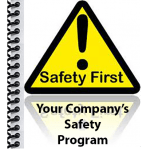Health and Safety Programs that are effectively managed can help companies achieve and maintain compliance standards and also assure that the health and safety of employees is safe-guarded. These programs are believed to reduce the extent and severity of work-related injuries and illnesses. A compliant workplace will ensure productivity is increased and costs are reduced.
Health and Safety Programs vary from company to company, depending on their policies and activities. However, the major elements that should never be overlooked when drafting Health and Safety Programs are the following:
1. Management-commitment and employee-involvement
Employers, employees and supervisors must know their roles and duties when it comes to health and safety in the workplace. These parties must be well aware of their powers, authority and the limits of these powers. A review must be done on certain intervals to determine if roles and responsibilities have been well-executed by all parties involved. Areas of defects must be worked upon and changes must be implemented, where necessary.
2. Work-site analysis
This analysis exercise must not only be aimed as identifying hazards and risks in the workplace. It must also be able to analyse changes in patterns and routines of working activities and potential hazards the new changes might pose. This can only be established if regular inspections of the workplace and work-sites are conducted. Hazards must be corrected as soon as they are identified. Employees must be stimulated, as it is their legal duty, to execute their responsibilities of reporting potential hazards and near misses to their superiors.
3. Hazard prevention and control
No reported hazard or risk should be taken for granted. All hazards and risks must be analysed and investigated even if they are near-misses. Control measures need to be implemented to control all risks identified. Records of all investigations should be kept so that trending injuries and illnesses can be further examined and control measures reviewed if they are found to be ineffective. Examples of control measures can be;
i. providing thorough inspections of facilities more regularly
ii. Intensifying equipment maintenance
iii. Providing effective Personal Protective Wear
4. Health and safety training
Training is one of the most effective ways of ensuring that a healthy and safe workplace is maintained. If training is provided to all employees on health and safety, Health and Safety Programs will become effective. Training can be used as a control measure for identified hazards as well . It helps prevent incidents in the workplace that might occur due to employees' lack of knowledge and skill. Training will ensure that all employees are educated about workplace hazards, skilled for hazards identification, reporting and informed on how to prevent incidents that will ultimately contribute to injuries. Training should be done by all parties involved in the workplace including Management, Supervisors, H & S representatives, First Aiders, Fire Fighters as well as all general employees. A completely trained workforce can, by far, reduce cases of incidents and injuries.
The importance of such Health and Safety Programs is that they ensure that workplaces always maintain health and safety standards required by law. To ensure Health and Safety Programs remain effective, constant reviews must be conducted because hazards change and appear all the time.
MAKROSAFE has all the know-how about the legislation and they assist companies in drafting and implementing Health and Safety Programs that are effective for their unique workplaces. Contact us today and let us assist you in that field and in anything else related to health and safety in the workplace.





Leave a comment